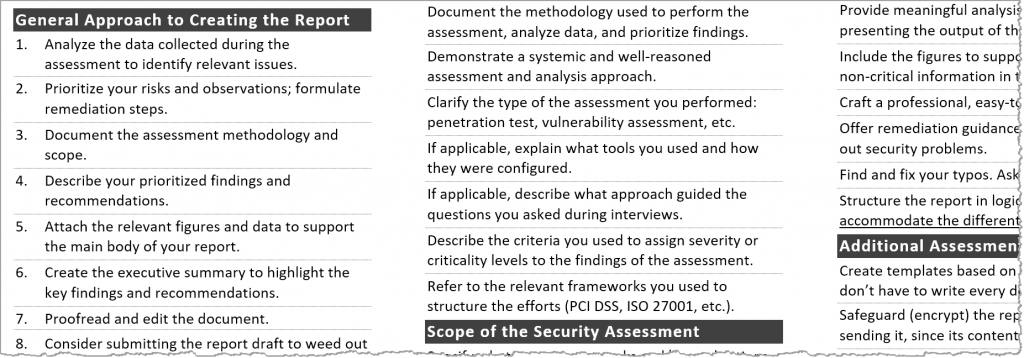
This cheat sheet offers advice for creating a strong report as part of your penetration test, vulnerability assessment, or an information security audit. To print, use the one-sheet PDF version; you can also edit the Word version for you own needs.
General Approach to Creating the Report
- Analyze the data collected during the assessment to identify relevant issues.
- Prioritize your risks and observations; formulate remediation steps.
- Document the assessment methodology and scope.
- Describe your prioritized findings and recommendations.
- Attach relevant the figures and data to support the main body of your report.
- Create the executive summary to highlight the key findings and recommendations.
- Proofread and edit the document.
- Consider submitting the report draft to weed out false positives and confirm expectations.
- Submit the final report to the intended recipient using agreed-upon secure transfer mechanism.
- Discuss the report's contents with the recipient on the phone, teleconference, or in person.
Analysis of the Security Assessment Data
- Share your insights beyond regurgitating the data already in existence.
- Consider what information provided to you is incomplete or might be a lie or half-truth.
- Look for patterns by grouping your initial findings by the affected resources, risk, issue category, etc.
- Identify for trends that highlight the existence of underlying problems that affect security.
- If examining scanner output, consider exploring the data using spreadsheets and pivot tables.
- Fill in the gaps in your understanding with follow-up scans, documentation requests, and interviews.
- Involve colleagues in your analysis to obtain other people's perspectives on the data and conclusions.
Assessment Methodology Documentation
- Document the methodology used to perform the assessment, analyze data, and prioritize findings.
- Demonstrate a systemic and well-reasoned assessment and analysis approach.
- Clarify the type of the assessment you performed: penetration test, vulnerability assessment, code review, etc.
- If applicable, explain what tools you used and how they were configured.
- If applicable, describe what approach guided the questions you asked during interviews.
- Describe the criteria you used to assign severity or critical levels to the findings of the assessment.
- Refer to the relevant frameworks you used to structure the assessment (PCI DSS, ISO 27001, etc.).
Scope of the Security Assessment
- Specify what systems, networks and/or applications were reviewed as part of the security assessment.
- State what documentation you reviewed, if any.
- List the people whom you interviewed, if any.
- Clarify the primary goals of the assessment.
- Discuss what contractual obligations or regulatory requirements were accounted for in the assessment.
- Document any items that were specifically excluded from the assessment's scope and explain why.
Documenting Conclusions
- Include both negative and positive findings.
- Account for the organization's industry, business model, and compliance requirements.
- Stay consistent with the methodology and scope.
- Prioritize findings related to security risks and remediation steps.
- Provide a practical remediation path, accounting for the organization's strengths and weaknesses.
Qualities of a Good Assessment Report
- Open with a strong executive summary that a non-technical reader can understand.
- Provide meaningful analysis, instead of merely presenting the output of assessment tools.
- Include the figures to support your analysis, placing non-critical information in the appendix.
- Craft a professional, easy-to-follow look.
- Offer remediation guidance beyond merely pointing out security problems.
- Find and fix your typos. Ask for help, if you can.
- Structure the report in logical sections to accommodate the different types of readers.
Additional Assessment Report Tips
- Create templates based on prior reports, so you don't have to write every document from scratch.
- Safeguard (encrypt) the report when storing and sending it, since its contents are probably sensitive.
- Use concrete statements; avoid passive voice.
- Explain the significance of your findings in the context of current threats and recent events.
- Put effort into making the report as brief as possible without omitting important and relevant contents.
Post-Scriptum
Authored by Lenny Zeltser, who's been writing as an information technology and security consultant, product manager, author and SANS instructor for many years.
Lenny also created a short writing course, SEC402: Cybersecurity Writing: Hack the Reader, for cybersecurity professionals.
Thanks for feedback to Dave Shackleford and John Strand. This cheat sheet, version 1.1, is distributed according to the Creative Commons v3 "Attribution" License.





